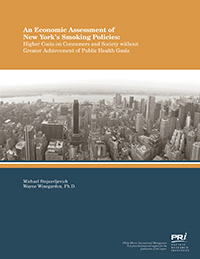By some measures, New Yorks decline in smoking incidence, particularly youth smoking incidence, was even less flattering. The percentage of 9th through 12th graders in the U.S. who smoked more than 10 cigarettes per day fell from 13.8 percent in 1997 to 7.8 percent in 2011, it rose in New York from 15.2 percent in 1997 to 16.3 percent in 2011.

Such a large amount of illegal sales also creates many adverse economic consequences for retailers, consumers and the government. The lost sales to legitimate retailers reduces overall retail sales and jobs in the state. A New York Association of Convenience Stores study found that if not for cigarette sales in the alternative market, cigarette retailing could be contributing nearly 13 thousand jobs, almost $500 million in wages, and $1.1 billion toward New Yorks economydouble its current contribution.
Consumers of legal tax-paid cigarettes also suffer; particularly low-income consumers. Due to the extremely high tax burden and the smaller incomes of low-income consumers, a New York Times article reported that low income smokers in New York spend 25 percent of their income on cigarettes.
The government of New York is also adversely impacted. Farrelly (2012) has estimated that the lost cigarette tax revenues due to illegal cigarette sales could have been as high as $1.4 billion in 2010or 2.2 percent of New Yorks total tax revenues for that year.

